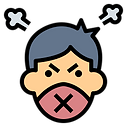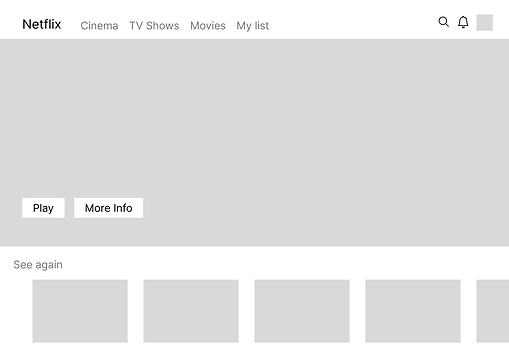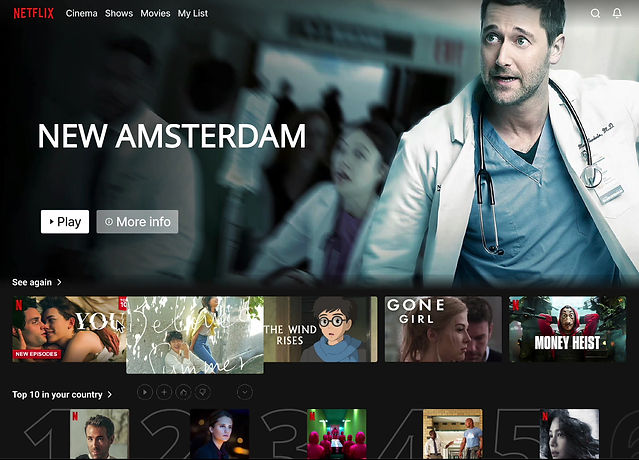Project:
"Netflix: Options to Confusions"
Role:
UX Researcher
UX Designer
Type:
Initiative Project
Background
-
Personal pain of searching experience
-
Decreasing motivation from excitement to quitting
-
"in an streaming app which has a lot of interesting options I want to watch, what's actually stop me?"
Hypothesis
Various movie options on Netflix confuse people while searching what to watch
Objective
To discover what are the causes of users' confusion while searching what to watch and also to discover opportunity to eliminate their confusion.
Research Questions
Does various options on Netflix create confusion while searching for movie?
How people search through the movie they want to watch?
What are their pain points?
What help them during the searching process?
What makes people confused while searching what to watch?
Methods
to answer the research question, I conducted in depth interview through Google meets to 5 participants with this criteria:
-
Netflix users
-
Have encountered issue of feeling indecisive and stop searching for movie/series to watch at least 3 times
Results and Interpretation
From the interviews that has been conducted, I arrange the answer into points on sticky notes and applied affinity diagram to generate some takeouts. as a result here are a number insights:

What users hate while using our product
-
User feel Netflix has many interesting options and they love it. But it confuse them to choose one.
-
They feel making decision is scary as it will create another effect such as picking a bad movie which lead to lost of time. they don't want to trap in that moment, in a nutshell thinking the best to pick is also spent their time. They got lost in their own complicated thought.
-
Time is ticking, they worried they pick the wrong movie and need to go all over again. and in the end, time wasted.

Our users behaviour
On Netflix
-
While finding something to watch, they are always interested to similar genre they've been watching.
-
Once the can't find something they like, they'll end up watching their comfort movie.
-
After going through a lot of thinking, it destroy their mood, which stop their motivation to watch something.
-
Once they already pick a series. it hooks them. They are willing to come back and stay in the app anytime they have enough time.
Outside Netflix
-
In the afternoon, they tend to have time to actually open tv streaming services but they didn't. Our user prefer to scroll on social media, play mobile game, or watching youtube. these activities plays role as a quick escape from reality and create a less guilty feeling. "Let me get one more scroll" , "One game won't hurt"
-
They tend to search on what people watch from social media/ movie related website, what other people watch influence them a lot.
-
Procrastinator. social media and other lite entertainment accessed through mobile phone is their quick escape from reality.
-
Once the picked a something on Netflix and didn't like it, they tend to quit the app and play around with YouTube, game, or social media
-
They go through YouTube comment section or others social media comments to find out other viewers perspective

What do they actually want?
Time is precious, it needs to be preserve as well as their mood. They want to make the most of leasure time by picking the right movie and not experience drowning in their own thought before making decision.
Based on data from user interviews, I organised my observations and categorise them through a customer journey map. This helps me to locate the user's pain points, in which areas can be improved along the user's journey using the app, and to create a more efficient journey.

After mapping the insights into the consumer journey, it visualize some links amongst some cases which help me connect and summarize into statements below. I found it very helpful to restating the connected dots as it will helps me with the ideation process.
Love hate relationships with options
With many options, users give up while searching for the movie as they already put too much thought on it and seems like they have no more energy to keep going.
at the same time, being aware that a lot of options are available on Netflix bring a sense of satisfaction and complete.
Begin again is not a choice.
Users stop once the movie turn them down. and to researching what to watch is an exhaustion.
Yes, we can’t control or expand user’s time. But for those potential, we can change the ilussion of complicated to a more convenient watching journey.
Recommendation is everything!
People most probably go on with the movie/ series as they already have idea on what to watch. Which this mostly gathered while they are on social media and their phone.
Let's ride on this!
Ideation
To comes up with probable solutions that can improve watching experience, I created HMW diagram as it helps me to clustering the problem and connect it with potential solution. Through out the process, I discovered that the problem revolve around two big ideas which can be implemented into two different main solution.

Done with arranged HMW diagram as the ideation process, I decided to create a feature where people have simpler decision making journey.

In term of making them into a real product, I firstly started with rough sketch in my notes, pouring my scattered ideas and visualisation which help me to have even better visual ideas and direction on where i'm heading to.

Based from the new user journey above. I created a new feature called Cinema mode, a feature where users will be facing a very limited option which "unconsciously" direct them to a choice . I also put the Cinema mode button in the top bar menu so it has good visibility.
Referring to Vanderbilt (2016) in a world full of choices "we human tend to be confused on what we like, but we always know what we don’t like". Inspired by that, I try to implement an "ilussion" of easy decision making by presenting options that contained of these item:
-
One movie/ series option that doesn’t align with their preference, which lead them to confidently think "Definitely not this one"
-
Two movie/ series options that based on their favourite genre which make them think that Netflix are keep on track with their preferred genre but at the same time still have control over movie/series options they'll be picking.


To get a clearer vision on how the new feature run, I also transformed the wireframe into the prototype. This Prototype is spesifically created for spesific persona with this analytic background:


Opportunity
Moving on to second outcome from the ideation process, I found that the gathered insights and HMW in this study is too premature to backup a massive feature development. Instead, it is very interesting as insights gather through this process open up a new possible solution.
So, what's the not so really "new"?
The second idea is basically creating a lite journey that enable people to discover what to watch by tapping on their mobile & social media behaviour. This also enable users to add their interest into our Watchlist feature. This idea expected to works as a "hook", that might help their confusion by helping them shortlisting outside their dedicated Netflix time.
To illustrate further, I roughly transform the social feature idea into a user journey. I think it will be very useful when next development process started especially while developing research plan as we already have a brief illustration on where we are heading to and what needed to focus on.

Lite, a scroll away, save time, help them with listing. In the other hand this is somehow quite align with how Netflix Fast Laugh feature works. So, is this the time to have it implemented in Indonesia?
Again, I believe this single research alone did not cover certain necessary issue such as how users interact with our watchlist feature? How does fast laugh feature that released in particular country performed? How users interact with it? How do they interact with social media in a very specific way? Therefore, instead of pushing to implement the second idea with numerous assumptions, I believe it will be better to use this as an insight as a new discovery of opportunity that support us to narrow further research and product exploration.
What's next?
-
Continue with iterating the Cinema mode feature
-
Prioritise the potentials based on related insights and rough user journey of social feature idea, then continue with research plan and product development.
Another notes and learning during the process
-
In the beginning I am aware that i should've done surveys to validate my hypothesis as well as getting more credible data on user's touch point and channel they use. It will help me to minimize assumption and create better decision when filtering touchpoint.
-
During the process, I also learn that running clickstream analysis would have be very helpful as one of the method used in this research process. In this case, through running clickstream analysis I expect to find more pattern such as our users' behaviour while using our app, what feature has least visit from users, how do they scroll before come to decision. I believe this also will help me in simplifying user journey and also when preparing more narrow interview questions.
-
Once you’ve gone through this case study, you might've found the process seems to be a bit different with common frameworks. In the previous cases, I tried to focus on the framework, that sometime eliminated my insights and critical thinking where sometimes I feel that I got drawn too deep into the steps and template rather than the problem-solving. Therefore, here I try to have a little more exploration on the journey, finding my own way of exploring. Might need improvement here and there, but I believe once I have opportunity to learn from a real experience, i’ll be improved, and find even better way.
